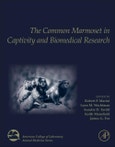The Common Marmoset in Captivity and Biomedical Research is the first text dedicated exclusively to this species,filling an urgent need for an encyclopedic compilation of the existing information. Sponsored by the American College of Laboratory Animal Medicine as part of its authoritative Blue Book series, the book covers the biology,management, diseases, and clinical and research applications of this important species. The common marmoset (Callithrix jacchus) has come of age in the scientific community as a behaviorally complex, cognitively advanced,small, prolific, and easily maintained nonhuman primate with many of the advantages of larger animals, such as macaques, but without the attendant physical and zoonotic risks.
Marmosets are currently being used in diverse areas of inquiry, including vision and auditory research, infectious disease, cognitive neuroscience, behavior, reproductive biology, toxicology and drug development, and aging. The marmoset genome has been sequenced and there is currently an intensive effort to apply gene editing technologies to the species. The creation of transgenic marmosets will provide researchers with a small nonhuman primate model to study a number of poorly understood disorders, like autism.
Please Note: This is an On Demand product, delivery may take up to 11 working days after payment has been received.
Table of Contents
Section I: BIOLOGY AND MANAGEMENT 1. Taxonomy and Natural History 2. The Anatomy of the Common Marmoset 3. Neuroanatomy of the Marmoset 4. Marmoset Nutrition and Dietary Husbandry 5. Husbandry and Housing of Common Marmosets 6. Normal Clinical and Biological Parameters of the Common Marmoset (Callithrix jacchus) 7. Behavior and Behavioral Management 8. Reproduction, Growth, and Development 9. Regulatory Considerations
Section II: DISEASES AND CLINICAL APPLICATIONS 10. Physical Examination, Diagnosis, and Common Clinical Procedures 11. Anesthesia and Common Surgical Procedures 12. Diseases of the Urogenital System 13. Diseases of the Gastrointestinal System 14. Bone, Muscle, and Skeletal Disease 15. Viral Diseases of Common Marmosets 16. Bacterial Diseases 17. Parasitic Diseases 18. Neoplastic Diseases
Section III: RESEARCH AND APPLICATIONS 19. The Genome of the Common Marmoset 20. Creating Genetically Modified Marmosets 21. Marmosets in Aging Research 22. The Marmoset Monkey as a Model for Visual Neuroscience 23. Marmosets in Neurologic Disease Research: Parkinson's Disease 24. Experimental Autoimmune Encephalomyelitis in the Marmoset as a Translational Model for Multiple Sclerosis 25. Marmosets in Auditory Research 26. The Marmoset as a Model in Behavioral Neuroscience and Psychiatric Research 27. The Use of the Marmoset in Toxicity Testing and Nonclinical Safety Assessment Studies 28. Experimental Infections of the Common Marmoset (Callithrix jacchus) 29. Insights Gained from Marmoset Endocrine Research








